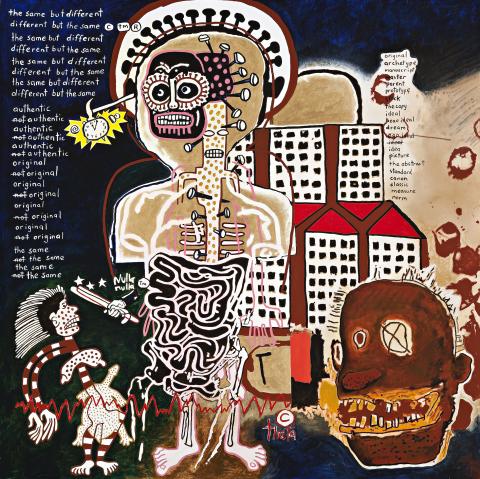NOTES TO BASQUIAT: (AB) ORIGINAL, 1999
GORDON BENNETT
synthetic polymer paint on linen
182.5 x 182.5 cm
signed, dated and inscribed verso: G Bennett 3-9-1999 / “NOTES TO BASQUIAT: (ab) original” / […]
Sherman Galleries, Sydney
Gene and Brian Sherman collection, Sydney
Gordon Bennett Notes to Basquiat: One Tense Moment (episode two), Sherman Galleries, Sydney, 5 November – 4 December 1999, cat. 5
Unscripted: Language in Contemporary Australian Art, Art Gallery of New South Wales, Sydney, 20 May – 24 July, 2005
‘The Galleries’, Sydney Morning Herald, 9 November 1999, p. 17
McLean I., Probability, rap and coincidence: notes to Basquiat in Gordon Bennett: One Tense Moment (episode two), exhibition catalogue, Sherman Galleries, Sydney, 1999, unpaginated (illus.)
Man + Space: Kwangju Biennale 2000, exhibition catalogue, Kwangju Biennale Foundation, South Korea, 2000, p. 273 (illus.)
Israel, G., Senior Artwise 2: Visual Arts 11-12, Jacaranda Press, Milton, Queensland, 2003, (illus., front cover and p. 163)
Murray Cree, L., Twenty: Sherman Galleries 1986-2006, Craftsman House / Thames and Hudson, Melbourne, 2006, p. 123 (illus.)
Notes to Basquiat (In The Future Art Will Not Be Boring), 1999, collection of the Art Gallery of New South Wales, Sydney
Notes to Basquiat (In the future everything will be as certain as it used to be) 1999, collection of The Wereldmuseum, Rotterdam
Notes to Basquiat: Double vision, 2000, collection of the National Gallery of Victoria, Melbourne
Notes to Basquiat: Poet and muse, 2000, collection of the National Gallery of Victoria, Melbourne
In the wake of his untimely death less than two years ago, Gordon Bennett has been championed as a ‘hero’ of Australian art who drew inspiration from Australia’s colonial past and postcolonial present to powerfully interrogate the role of language in structuring the ideologies that so determine our personal and cultural identities. Indeed, perhaps more directly and explicitly than any other Australian artist, he engaged in the debate on republicanism, sovereignty and citizenship in an effort to highlight the plight of indigenous people not just locally, but internationally, who have become estranged as a result of colonialism. Arguing that the codes of Western art, literature, law and science introduced with European settlement have become a prison from which indigenous people cannot escape – but rather, only appropriate – Bennett sought to picture such manifold ‘conspiracies’, employing the deconstructivist aesthetic of postmodernism to re-present the histories and politics underlying the Australian social landscape.
With the invitation to exhibit in a contemporary art fair at New York’s Gramercy Hotel as catalyst, in 1998 Bennett embarked upon his celebrated ‘Notes to Basquiat’ series paying homage to the work of Neo-Expressionist painter Jean-Michel Basquiat – the first African – American to receive international art world acclaim who also shared a similar preoccupation with semiotics and visual language as instruments of marginalisation. Conceived as an ‘open letter’ to Basquiat who died ten years earlier, the series appropriates the raw street style for which Basquiat became renowned in an attempt to communicate via ‘the language of the New York context… the similarities and crossconnections of our shared experience as human beings in separate worlds that each seek[s] to exclude, objectify and dehumanise the black body and person.’1 Yet if Bennett borrows ‘signature’ motifs from Basquiat’s oeuvre such as his use of lists and rap-like banter, he nevertheless imbues them with his own uniquely Australian symbolism. As Jill Bennett elucidates, Bennett ‘...does not simply imitate or act as Basquiat... [Rather] he is interested in how Basquiat’s work might be encountered from a different place, and what happens when different accounts of history and experience are registered simultaneously within a given frame...’2
Accordingly, in the present Notes to Basquiat: (Ab)original, 1999, the experience of race and life generally in the northern and southern hemispheres is both differentiated and conflated through Bennett’s highly sophisticated mimicry of Basquiat’s spontaneous urban style. Anchoring the composition is a confronting tortured skeletal figure, that embodies a shared stereotyping of ‘blackness’, yet more universally suggests a common humanity – that beneath one’s skin ‘we are all alike underneath’. Such is reiterated by the work’s unfolding lines of text ‘the same but different / different but the same’ – a notion which not only reverberates throughout the entire series, but is similarly reflected in Bennett’s knowing relationship to Basquiat and his practice. Ultimately betraying Bennett’s highly idiosyncratic vision however, is his characteristic engagement of the viewer here through his thesaurus inspired word-play designed to activate the complex web connecting sight, speech and thought, and thus highlights the links between history and meaning established in his oeuvre. Deliberately inconclusive – ‘original’, ‘archetype’, ‘manuscript’, ‘master’, ‘parent’ etc – Notes to Basquiat: (Ab)original eloquently attests to the compelling possibilities offered by Bennett’s art and its embodiment of ‘a process being kept in play’; and as he poignantly muses, ‘Poetry doesn’t seek closure on its meaning. I think it seeks to go beyond the words on the paper into a world of metaphor, allegory, images and ideas in order to say ‘something’ that may not be said with just words.’3
1. Bennett, G., quoted in Gordon Bennett, National Gallery of Victoria, Melbourne, 2007, p. 21
2. ibid.
3. ibid., p. 22
VERONICA ANGELATOS
